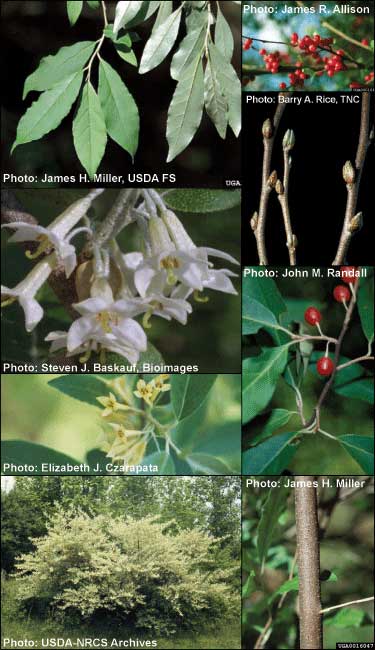|
Autumn Olive (Elaeagnus umbellata)
What problems does autumn olive cause? Like most invasive plants, autumn olive replaces native plants in high quality natural areas, which in turn reduces critical food resources for birds, butterflies, and other wild creatures. Autumn olive is perhaps the most notorious invasive plant, both for the irony of its spread by organizations now seeking to control it and for how dominant the plant has become. Although it does provide a healthy supply of late season berries, autumn olive monocultures do not sustain insect populations during the growing season that songbirds require for their nestlings to survive to adulthood. What does autumn olive look like? Autumn olive is a shrub that typically grows 15-20ft. Although tolerating a range of conditions, it is most common in old fields, open woods, and forest edges. In the fall, it is loaded with bright red berries that are edible. Leaves grow alternately and are speckled silver, especially along the underside. A more tree-like and more silvery plant might be its cousin, Russian olive. How do I manage autumn olive? Explore native alternatives for wildlife plantings like buffaloberry (Shepherdia canadensis) or wild plum (Prunus americana). Effective autumn olive control requires careful goal setting and typically many years of effort. Before embarking on a control program, survey your site for other similarly aggressive species so you can best prioritize your efforts. For example, glossy buckthorn in wetlands is typically just as aggressive as autumn olive, but control is often more affordable because most local populations are not so far along. Young olive shrubs may be chopped easily with loppers, requiring far less effort than mature forms. Re-sprouting will be a problem without herbicide use. Shrubs allowed to mature produce prolific seed, putting intense pressure on all surrounding natural areas within a bird’s range. You can also check out the recording of our Autumn Olive Workshop that walks through everything from ID to treatment options to cost-share opportunities. |
| habitatmatters.org |
Contact US231-252-4148
3334 Veterans Drive Unit A Traverse City, Michigan 49685 |
Pleasant Peninsula Design, Habitat Matters 2017


